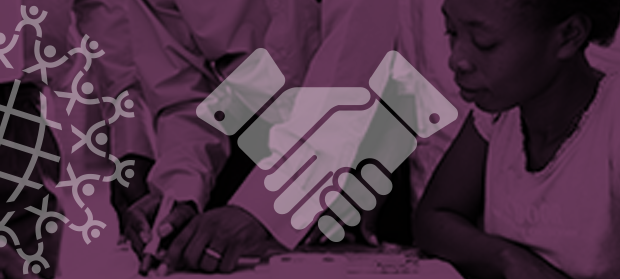Where We Work
See our interactive map


The Ebola outbreak of West Africa didn’t hit overnight like a tsunami or earthquake—rather, the disaster gradually took over the region beginning in December 2013, really gaining speed in late summer of 2014. Along the way, weaknesses in health systems, including support to frontline health workers, were exposed, accelerating the spread of the virus. Like many in the field of global health and development, my colleagues and I at IntraHealth International wanted to find a way to help. For over 35 years, IntraHealth has focused on supporting health workers and health systems.
One of the organization’s niche areas is health information systems, in particular the open source health worker information system (iHRIS) that helps ministries of health and other stakeholders to collect, analyze, and use data on their health workforces.
mHero uses simple SMS and interactive voice response technology on mobile phones.
With this commitment to health workers, expertise in technology, and desire to collaborate with partners to respond to the Ebola outbreak in West Africa, IntraHealth, along with UNICEF, created mHero, a two-way communication platform to support dialogue between ministries of health and health workers. This tool supports health worker training, flash surveys to gather information in real time, and other communications using simple SMS and interactive voice response technology on mobile phones.
mHero: The Beginning
Creating new technologies takes significant time and a lot of committed resources—none of which were readily available as Ebola spread through the streets of Monrovia and the hills of Sierra Leone. That is why IntraHealth’s approach to supporting health workers and health systems was to build on what was already there and what people already know, a concept especially important in a crisis. Before the Ebola outbreak, IntraHealth had been discussing integrating its iHRIS system with UNICEF’s RapidPro software so that ministries of health could pull health worker data—including their mobile phone numbers, where they are deployed, and their cadres—and send targeted SMS to health workers. In late August, IntraHealth and UNICEF jointly decided to make this happen to support the Ebola response.Because both systems were already in use, it would be relatively easy to support the interoperability necessary to stand up the technology, which the team coined mHero. While developers were working on the technology at the UNICEF Innovation Lab in Kampala, program implementers like myself were reaching out to our ministry of health colleagues in the Ebola outbreak countries to see if something like this would be useful in the Ebola response.
The commitment of the individuals involved was intense.
The US Agency for International Development, through the K4Health project, provided funding so we could document what the mHero platform could do, brand the technology, and fund the development of technology interoperability.
The commitment of the individuals involved was intense, especially as more headlines of the Ebola outbreak took over. Intrahealth and our in-country and global stakeholders were in constant contact, highlighting issues, working together through challenges, and jointly recommending solutions to get the platform to pilot.
Within weeks, IntraHealth, with financial support from UNICEF, was able to provide on the ground support to test the technology and thoughtfully plan implementation in Liberia leading to the pilot in four counties in early December.
It’s Not the Technology, It’s the People that Make It Work
mHero, like many digital health platforms, is technology-based and relies on experts in information and communications technology to make them function properly. Also needed are internet capabilities, mobile networks, and hardware to ensure deployment is successful.
But the most important part, in my opinion, is the need for committed people, leading, learning, and adapting technology implementation. Mobile tools such as mHero only really work if you have users who engage and learn from and adapt their behaviors after using the technology.
So who are these people?They are your in-country champions—your leaders and advocates on the ground closest to the deployment of the technology. They literally drive the deployment of the systems; advocate for their use, and ensure they are used to their full potential.
They are your conductors, or your coordinators, who are looking at how systems and technologies can work together. In the Ebola response, many stakeholders have come to ministries of health to help—you need leaders to look around the table and see who is there, what synergies exist, how you can work together, and then take action to coordinate efforts. Cooperation does not necessarily mean collaboration, so you really have to lead and drive partnerships to make sure systems work for those who use them.
The users are why we create tools like mHero in the first place.
Perhaps the most important people are the users. They are why we have created tools like mHero in the first place. It is important to find out what would help users the most by deploying the technology.
Many of us who gather user-feedback by surveys, interviews, or just informal knowledge exchange, find out that what we initially planned to do may not be the thing that is most needed. Adapting our “workplan” or “implementation plan” is part of effective implementation.
Next for mHero
Over the next few months, the mHero team is continuing to scale up in Liberia and plans to implement the platform in Guinea, with support from the USAID Grand Challenge for Ebola.
We are continuing to talk to partners, both globally and in the outbreak countries, to ensure that mHero is adaptive to their needs and not duplicative with other efforts. Too, we are working with UNICEF and other partners to scale mHero in non-Ebola outbreak countries to be used as a mobile tool to strengthen health systems and support health workers.
Along the way, we’ll continue to collaborate, learn, and adapt our implementation so that we are responsive to the most pressing needs of the people.
This post originally appeared on USAID Learning Lab.
Get the latest updates from the blog and eNews




